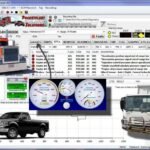DIAGNOSTIC RESPONSE:
SOL OFF, Inhibit TCC operation, Inhibit main modulation, DNA
CIRCUIT DESCRIPTION:
The high side drivers are connected to the high side circuits of the solenoids and commanded on during normal operation. The high side drivers serve as a master switch to supply battery voltage to the low side drivers. High side drivers are turned on during TCM initialization and remain on during normal operation. High side drivers are turned off during cranking and for certain diagnostic responses. The open circuit diagnostic is determined by monitoring the status of the low side drivers. If two or more of the low side drivers circuits are detected by the TCM in a failed open/low state that are supplied by a particular high side driver circuit, the problem is assumed to be on the high side of the load and a high side driver fault becomes active instead of two or more low side driver faults becoming active. There may or may not be low side driver faults present with this DTC. High Side Driver 2 (HSD2) supplies battery voltage to the Pressure Control Solenoid 1 (PCS1), Pressure Control Solenoid 2 (PCS2), Pressure Control Solenoid 3 (PCS3), and Shift Solenoid 1 (SS1) via wire 171. The TCM regulates control current to the solenoids by switching the appropriate low side driver on and off.
CONDITIONS FOR RUNNING THE DTC:
1. DTC enabled with ignition ON, engine OFF, and battery voltage greater than 9 volts.
2. HSD2 is commanded ON.
3. DTC disabled while engine is cranking longer than 4 seconds, and battery voltage is less than 10 volts.
4. DTC re-enabled once engine is running and TCM is initialized normally.
CONDITIONS FOR SETTING THE DTC:
This DTC sets when the TCM detects two or more low side drivers connected to HSD2, e.g., PCS1, PCS2, PCS3, or SS 1 low side drivers have been detected in a failed low state and HSD2 voltage is less than 6 volts.
ACTION TAKEN WHEN THE DTC SETS:
When DTC P2669 is active:
1. The DTC sets while in a forward range, then shifts to another forward range. If failure occurs while in Neutral (N), the transmission remains in Neutral (N). If failure occurs while in Reverse (R), the transmission remains in Reverse (R) or shifts to Neutral (N). Once range is attained, transmission is locked in this range and there is no response to shift selector requests.
2. The TCM inhibits TCC engagement.
3. Main Modulation is inhibited.
4. DTC is stored in the TCM history.
5. The CHECK TRANS light illuminates.
6. The TCM freezes shift adapts (DNA).
CONDITIONS FOR CLEARING THE DTC:
Use the diagnostic tool to clear the DTC from the TCM history. The TCM automatically clears the DTC from the TCM history if the vehicle completes 40 warm-up cycles without failure.
DIAGNOSTIC AIDS:
DTC P2669 can be caused by:
1. HSD2 circuit issues such as:
– W171 shorted to another wire in chassis harness.
– W171 (terminal 6 of 20-way) shorted to another wire in the internal transmission harness.
– W171 high resistance or an open circuit in chassis harness.
– W171 (terminal 6 of 20-way) high resistance or an open circuit in internal transmission harness.
2. Two or more low side driver circuit issues with PCS1, PCS2, PCS3, or SS1.
3. PCS1 issues such as:
– W136 shorted to another wire in chassis harness.
– W136 shorted (terminal 4 of 20-way) to another wire in the internal transmission harness.
– W136 high resistance or an open circuit in chassis harness.
– W136 (terminal 4 of 20-way) high resistance or an open circuit in internal transmission harness.
4. PCS2 issues such as:
– W152 shorted to another wire in chassis harness.
– W152 shorted (terminal 5 of 20-way) to another wire in the internal transmission harness.
– W152 high resistance or an open circuit in chassis harness.
– W152 (terminal 5 of 20-way) high resistance or an open circuit in internal transmission harness.
5. PCS3 issues such as:
– W133 shorted to another wire in chassis harness.
– W133 shorted (terminal 9 of 20-way) to another wire in the internal transmission harness.
– W133 high resistance or an open circuit in chassis harness.
– W133 (terminal 9 of 20-way) high resistance or an open circuit in internal transmission harness.
6. SS 1 issues such as:
– W151 shorted to another wire in chassis harness.
– W151 shorted (terminal 10 of 20-way) to another wire in the internal transmission harness.
– W151 high resistance or an open circuit in chassis harness.
– W151 high resistance or an open circuit (terminal 10 of 20-way) in internal transmission harness.
7. Defective solenoids PCS1, PCS2, PCS3, SS1.
8. Unlocked connectors, expanded terminals, poor pin crimps or unlocked pins causing high resistance or open circuit.
9. Defective TCM.
Review applicable information in Control System and Transmission Specifications to find additional circuit specifications, system and connector diagrams, and troubleshooting tips.


 AGCO
AGCO ALLISON
ALLISON BENDIX
BENDIX BOBCAT
BOBCAT CAT
CAT CLAAS
CLAAS CNH
CNH DAF
DAF DETROIT
DETROIT EATON
EATON FREIGHTLINER
FREIGHTLINER HINO
HINO HITACHI
HITACHI ISUZU
ISUZU JCB
JCB JOHN DEERE
JOHN DEERE JPROZZ
JPROZZ MAGIC TUNER
MAGIC TUNER MAN
MAN Navistar
Navistar PACCAR
PACCAR PERKINS
PERKINS PF DIAGNOSE
PF DIAGNOSE PSI POWERLINK
PSI POWERLINK RENAULT
RENAULT SCANIA
SCANIA THERMO KING
THERMO KING UD NISSAN
UD NISSAN VOLVO
VOLVO WABCO
WABCO ZF TESTMAN
ZF TESTMAN
 BELL
BELL BENDIX
BENDIX BOBCAT
BOBCAT CARRIE
CARRIE DAF
DAF DETROIT
DETROIT EATON
EATON FUSO
FUSO MACK
MACK
 Cumminz
Cumminz ISB4.5 CM2150
ISB4.5 CM2150 All Engines (2017 Emissions)
All Engines (2017 Emissions) PACCAR
PACCAR











![The Doosan Diagnostic Tool DX22 Electronic Marine ECU Analyzer 01.00R5 [2024.03] is designed for optimal engine performance in marine applications. This tool offers advanced diagnostic capabilities and is compatible with a variety of marine engines. It plays a crucial role in maintaining and managing engine health. The latest version includes features that enhance connectivity and user experience, making it a valuable asset for marine operators and technicians.](https://ecmtrucks.com/wp-content/uploads/2024/08/DOOSAN-DIAGNOSTIC-TOOL-DX22-ELECTRONIC-MARINE-ECU-ANALYZER-01.00R5-2024.03-400x400.png)




Reviews
Clear filtersThere are no reviews yet.